Medulla Poll Everywhere
1/12
There's no tags or description
Looks like no tags are added yet.
Name | Mastery | Learn | Test | Matching | Spaced |
|---|
No study sessions yet.
13 Terms

Identify the structure indicated by the outline and letter "A".
A. Fasciculus cuneatus
B. Fasciculus gracilus
C. Spinal trigeminal tract
D. Medial lemniscus
E. Pyramids
A. Fasciculus cuneatus
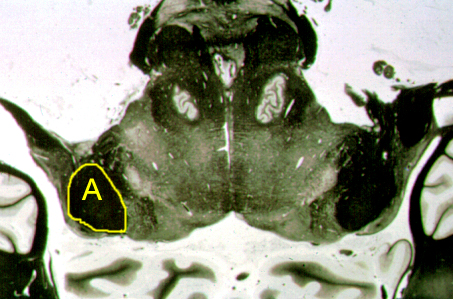
Identify the structure indicated by the outline and letter "A".
A. Pyramid
B. Middle cerebellar peduncle
C. Inferior cerebellar peduncle
D. Dorsal cochlear nucleus
E. Inferior vestibular nucleus
C. Inferior cerebellar peduncle
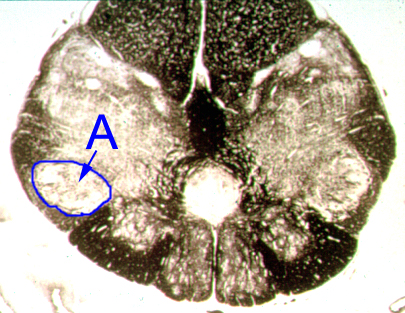
Identify the structure indicated by the outline and letter "A".
A. Fasciculus cuneatus
B. Fasciculus gracilus
C. Spinal trigeminal nucleus
D. Anterolateral system
E. Pyramidal decussation
C. Spinal trigeminal nucleus
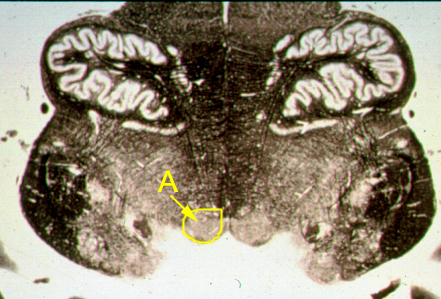
Identify the structure indicated by the outline and letter "A".
A. Dorsal motor nucleus of the vagus
B. Solitary nucleus and tract
C. Hypoglossal nucleus
D. 4th ventricle
E. Pyramid
C. Hypoglossal nucleus
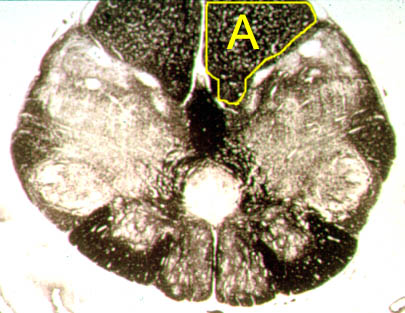
Identify the structure indicated by the outline and letter "A".
A. Pyramid
B. Medial lemniscus
C. Inferior olivary nucleus
D. Anterolateral system
E. Fasciculus gracilus
A. Pyramid
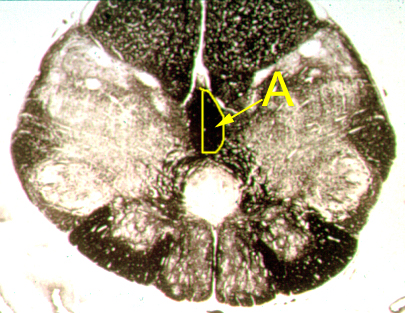
If structure "A" is lesioned, describe the signs/symptoms that will be present.
A. Contralateral loss of pain and temp to the body
B. Ipsilateral loss of vibratory sense to the lower half of the body
C. Contralateral loss of fine touch to the body
D. Ipsilateral spastic paresis to the body
E. Ipsilateral flaccid paralysis to the lower extremity
C. Contralateral loss of fine touch to the body
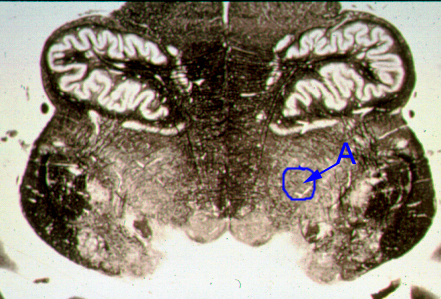
Identify the structure indicated by the outline and letter "A".
A. Dorsal motor nucleus of the vagus
B. Anterolateral system
C. Spinal trigeminal nucleus
D. Medial lemniscus
E. Nucleus ambiguous
E. Nucleus ambiguous

Describe the signs/symptoms if structure "A" is lesioned.
A. Contralateral flaccid paralysis to the body
B. Ipsilateral spastic paresis to the body
C. Bilateral loss of pain and temp to the body
D. Bilateral spastic paresis to the body
E. Ipsilateral loss of tactile to the body
D. Bilateral spastic paresis to the body
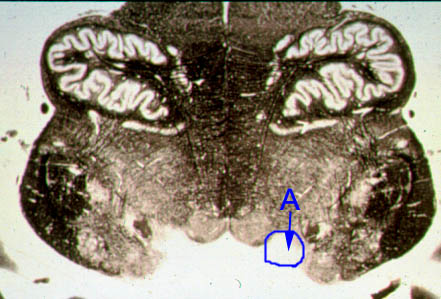
Identify the structure indicated by the outline and letter "A".
A. Hypoglossal nucleus
B. Dorsal motor nucleus of the vagus
C. Nucleus ambiguous
D. Abducens nucleus
E. Inferior cerebellar peduncle
B. Dorsal motor nucleus of the vagus
What artery supplies the lateral aspect of the mid-medulla:
A. Anterior spinal artery
B. Vertebral artery
C. Posterior inferior cerebellar artery
D. Posterior inferior cerebral artery
E. Basilar artery
C. Posterior inferior cerebellar artery

Describe the signs/symptoms you will see if structure "A" is lesioned.
A. Contralateral loss of pain and temperature to the body
B. Ipsilateral hypertonia to the body
C. Contralateral spastic paresis to the body
D. Ipsilateral loss of vibratory sense to the body
E. Ipsilateral flaccid paralysis to the body
C. Contralateral spastic paresis to the body
What is brainstem reticular formation
It is a meshwork of diffuse nuclei and tracts that run throughout the brainstem